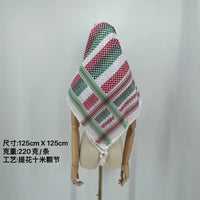Different Ways to Wear the Shemagh in Arab Countries
The shemagh, also known as a keffiyeh or ghutra, is a traditional Arab headscarf worn in various styles across the Arab world. Its widespread usage can be attributed to the close proximity of Arab nations, population migrations, and the rich cultural exchanges between these countries. Each region has developed its unique way of wearing the shemagh, with certain styles gaining popularity for specific occasions or among particular social groups. Here are some of the most well-known styles:

- The "Bint Al Bakkar" Style
The "Bint Al Bakkar" style is currently one of the most fashionable ways to wear the shemagh, though its origins remain unclear. This style is complex and requires a high level of dexterity to master. When done correctly, it exudes elegance and refinement. The shemagh is twisted before being folded over the head, with the ends left to dangle down, creating a sophisticated look that is both traditional and modern.
- The VIP Version
The VIP version of the shemagh is often seen on high-ranking officials, dignitaries, and ministers. This style is characterized by letting the two ends of the shemagh fall freely while creating a slight fold at the front. It is reserved for formal occasions and adds a touch of prestige to the wearer.
- The Eagle Style
The Eagle style is practical and commonly used during desert excursions or in cold weather. To achieve this look, both ends of the shemagh are thrown over the opposite shoulder, providing additional protection against the elements while maintaining a traditional appearance.
- The School-Teacher Look
The School-Teacher Look is a simple and functional way of wearing the shemagh, popular among educators. In this style, the ends of the shemagh are simply draped behind the back, offering freedom of movement while still maintaining the classic look of the headscarf.
- The Cobra Style
Born in the 1990s, the Cobra style is arguably the most iconic way to wear the shemagh. It involves shaping the shemagh to resemble a cobra, with one end forming a "hood" over the head. While visually striking, this style is somewhat restrictive, as it requires frequent adjustments to maintain the cobra effect. It is also known to cause neck discomfort due to its tight fit.
- The Modest Style
The Modest style is a straightforward way to wear the shemagh. The scarf is placed on top of a chachiya (a traditional skullcap) and secured with an iqal (a black cord). One end of the shemagh is then draped over the opposite shoulder, creating a look that is both simple and respectful.
- The Abu Rashed Style
The Abu Rashed style is named after the lawyer Khaled Abu Rashed, who became famous for defending a reckless driver in 2005. This style involves folding one of the shemagh's ends over the head, a technique that Abu Rashed mastered and popularized. It is a bold and distinctive way to wear the shemagh, often associated with confidence and authority.
- The Butterfly Style
In contrast to the Cobra style, the Butterfly style allows for greater ease of movement and comfort. The shemagh is arranged so that the face is well-framed, with the ends tucked behind the back and over one shoulder. This style is not only practical but also adds a touch of elegance, making it suitable for various occasions.
Conclusion
The shemagh is more than just a piece of cloth; it is a symbol of cultural identity and tradition in the Arab world. Each style of wearing the shemagh reflects the wearer’s social status, the occasion, and regional customs. Whether it’s the intricate Bint Al Bakkar style or the practical Eagle style, the way a shemagh is worn speaks volumes about the person wearing it.





